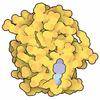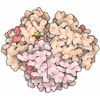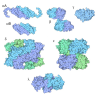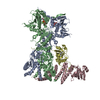[English] 日本語
 Yorodumi
Yorodumi- PDB-8qmo: Cryo-EM structure of the benzo[a]pyrene-bound Hsp90-XAP2-AHR complex -
+ Open data
Open data
- Basic information
Basic information
| Entry | Database: PDB / ID: 8qmo | |||||||||||||||
|---|---|---|---|---|---|---|---|---|---|---|---|---|---|---|---|---|
| Title | Cryo-EM structure of the benzo[a]pyrene-bound Hsp90-XAP2-AHR complex | |||||||||||||||
 Components Components |
| |||||||||||||||
 Keywords Keywords | TRANSCRIPTION / detoxification / chemical pollutants / exposome | |||||||||||||||
| Function / homology |  Function and homology information Function and homology informationGAF domain binding / cytosolic aryl hydrocarbon receptor complex / regulation of B cell proliferation / cellular response to 2,3,7,8-tetrachlorodibenzodioxine / HSP90-CDC37 chaperone complex / regulation of adaptive immune response / nuclear aryl hydrocarbon receptor complex / negative regulation of proteasomal protein catabolic process / Aryl hydrocarbon receptor signalling / cellular response to molecule of bacterial origin ...GAF domain binding / cytosolic aryl hydrocarbon receptor complex / regulation of B cell proliferation / cellular response to 2,3,7,8-tetrachlorodibenzodioxine / HSP90-CDC37 chaperone complex / regulation of adaptive immune response / nuclear aryl hydrocarbon receptor complex / negative regulation of proteasomal protein catabolic process / Aryl hydrocarbon receptor signalling / cellular response to molecule of bacterial origin / aryl hydrocarbon receptor complex / negative regulation of T cell mediated immune response to tumor cell / histone methyltransferase binding / dynein axonemal particle / receptor ligand inhibitor activity / Xenobiotics / protein kinase regulator activity / ATP-dependent protein binding / positive regulation of protein localization to cell surface / Phase I - Functionalization of compounds / protein folding chaperone complex / protein targeting to mitochondrion / blood vessel development / Respiratory syncytial virus genome replication / telomerase holoenzyme complex assembly / positive regulation of transforming growth factor beta receptor signaling pathway / Uptake and function of diphtheria toxin / dendritic growth cone / TPR domain binding / E-box binding / Assembly and release of respiratory syncytial virus (RSV) virions / aryl hydrocarbon receptor binding / TFIID-class transcription factor complex binding / The NLRP3 inflammasome / protein phosphatase activator activity / Sema3A PAK dependent Axon repulsion / regulation of protein ubiquitination / HSF1-dependent transactivation / response to unfolded protein / Endogenous sterols / HSF1 activation / Attenuation phase / chaperone-mediated protein complex assembly / telomere maintenance via telomerase / axonal growth cone / RHOBTB2 GTPase cycle / Purinergic signaling in leishmaniasis infection / cis-regulatory region sequence-specific DNA binding / : / DNA polymerase binding / heat shock protein binding / supramolecular fiber organization / negative regulation of proteasomal ubiquitin-dependent protein catabolic process / protein folding chaperone / peptide binding / xenobiotic metabolic process / cellular response to interleukin-4 / Gene and protein expression by JAK-STAT signaling after Interleukin-12 stimulation / cellular response to forskolin / ESR-mediated signaling / HSP90 chaperone cycle for steroid hormone receptors (SHR) in the presence of ligand / TBP-class protein binding / cellular response to cAMP / protein maturation / placenta development / nitric-oxide synthase regulator activity / positive regulation of cell differentiation / peptidyl-prolyl cis-trans isomerase activity / circadian regulation of gene expression / Hsp90 protein binding / ATP-dependent protein folding chaperone / PPARA activates gene expression / DDX58/IFIH1-mediated induction of interferon-alpha/beta / Regulation of actin dynamics for phagocytic cup formation / response to toxic substance / negative regulation of inflammatory response / kinase binding / transcription coactivator binding / tau protein binding / histone deacetylase binding / nuclear receptor activity / Chaperone Mediated Autophagy / sequence-specific double-stranded DNA binding / positive regulation of nitric oxide biosynthetic process / disordered domain specific binding / MHC class II protein complex binding / The role of GTSE1 in G2/M progression after G2 checkpoint / unfolded protein binding / melanosome / protein folding / double-stranded RNA binding / regulation of protein localization / cellular response to heat / regulation of gene expression / secretory granule lumen / transcription regulator complex / Estrogen-dependent gene expression / ficolin-1-rich granule lumen / Potential therapeutics for SARS / RNA polymerase II-specific DNA-binding transcription factor binding Similarity search - Function | |||||||||||||||
| Biological species |  Homo sapiens (human) Homo sapiens (human) | |||||||||||||||
| Method | ELECTRON MICROSCOPY / single particle reconstruction / cryo EM / Resolution: 2.76 Å | |||||||||||||||
 Authors Authors | Kwong, H.S. / Grandvuillemin, L. / Sirounian, S. / Ancelin, A. / Lai-Kee-Him, J. / Carivenc, C. / Lancey, C. / Ragan, T.J. / Hesketh, E.L. / Bourguet, W. / Gruszczyk, J. | |||||||||||||||
| Funding support |  France, 4items France, 4items
| |||||||||||||||
 Citation Citation |  Journal: J Mol Biol / Year: 2024 Journal: J Mol Biol / Year: 2024Title: Structural Insights into the Activation of Human Aryl Hydrocarbon Receptor by the Environmental Contaminant Benzo[a]pyrene and Structurally Related Compounds. Authors: Hok-Sau Kwong / Matteo Paloni / Loïc Grandvuillemin / Savannah Sirounian / Aurélie Ancelin / Josephine Lai-Kee-Him / Marina Grimaldi / Coralie Carivenc / Claudia Lancey / Timothy J Ragan / ...Authors: Hok-Sau Kwong / Matteo Paloni / Loïc Grandvuillemin / Savannah Sirounian / Aurélie Ancelin / Josephine Lai-Kee-Him / Marina Grimaldi / Coralie Carivenc / Claudia Lancey / Timothy J Ragan / Emma L Hesketh / Patrick Balaguer / Alessandro Barducci / Jakub Gruszczyk / William Bourguet /   Abstract: The aryl hydrocarbon receptor (AHR) is a ligand-dependent transcription factor belonging to the bHLH/PAS protein family and responding to hundreds of natural and chemical substances. It is primarily ...The aryl hydrocarbon receptor (AHR) is a ligand-dependent transcription factor belonging to the bHLH/PAS protein family and responding to hundreds of natural and chemical substances. It is primarily involved in the defense against chemical insults and bacterial infections or in the adaptive immune response, but also in the development of pathological conditions ranging from inflammatory to neoplastic disorders. Despite its prominent roles in many (patho)physiological processes, the lack of high-resolution structural data has precluded for thirty years an in-depth understanding of the structural mechanisms underlying ligand-binding specificity, promiscuity and activation of AHR. We recently reported a cryogenic electron microscopy (cryo-EM) structure of human AHR bound to the natural ligand indirubin, the chaperone Hsp90 and the co-chaperone XAP2 that provided the first experimental visualization of its ligand-binding PAS-B domain. Here, we report a 2.75 Å resolution structure of the AHR complex bound to the environmental pollutant benzo[a]pyrene (B[a]P). The structure substantiates the existence of a bipartite PAS-B ligand-binding pocket with a geometrically constrained primary binding site controlling ligand binding specificity and affinity, and a secondary binding site contributing to the binding promiscuity of AHR. We also report a docking study of B[a]P congeners that validates the B[a]P-bound PAS-B structure as a suitable model for accurate computational ligand binding assessment. Finally, comparison of our agonist-bound complex with the recently reported structures of mouse and fruit fly AHR PAS-B in different activation states suggests a ligand-induced loop conformational change potentially involved in the regulation of AHR function. | |||||||||||||||
| History |
|
- Structure visualization
Structure visualization
| Structure viewer | Molecule:  Molmil Molmil Jmol/JSmol Jmol/JSmol |
|---|
- Downloads & links
Downloads & links
- Download
Download
| PDBx/mmCIF format |  8qmo.cif.gz 8qmo.cif.gz | 646.9 KB | Display |  PDBx/mmCIF format PDBx/mmCIF format |
|---|---|---|---|---|
| PDB format |  pdb8qmo.ent.gz pdb8qmo.ent.gz | 533.3 KB | Display |  PDB format PDB format |
| PDBx/mmJSON format |  8qmo.json.gz 8qmo.json.gz | Tree view |  PDBx/mmJSON format PDBx/mmJSON format | |
| Others |  Other downloads Other downloads |
-Validation report
| Arichive directory |  https://data.pdbj.org/pub/pdb/validation_reports/qm/8qmo https://data.pdbj.org/pub/pdb/validation_reports/qm/8qmo ftp://data.pdbj.org/pub/pdb/validation_reports/qm/8qmo ftp://data.pdbj.org/pub/pdb/validation_reports/qm/8qmo | HTTPS FTP |
|---|
-Related structure data
| Related structure data |  18498MC M: map data used to model this data C: citing same article ( |
|---|---|
| Similar structure data | Similarity search - Function & homology  F&H Search F&H Search |
- Links
Links
- Assembly
Assembly
| Deposited unit | 
|
|---|---|
| 1 |
|
- Components
Components
-Protein , 3 types, 4 molecules ABCD
| #1: Protein | Mass: 84213.141 Da / Num. of mol.: 2 Source method: isolated from a genetically manipulated source Source: (gene. exp.)  Homo sapiens (human) / Gene: HSP90AB1, HSP90B, HSPC2, HSPCB / Production host: Homo sapiens (human) / Gene: HSP90AB1, HSP90B, HSPC2, HSPCB / Production host:  #2: Protein | | Mass: 37691.047 Da / Num. of mol.: 1 Source method: isolated from a genetically manipulated source Source: (gene. exp.)  Homo sapiens (human) / Gene: AIP, XAP2 / Production host: Homo sapiens (human) / Gene: AIP, XAP2 / Production host:  #3: Protein | | Mass: 49492.559 Da / Num. of mol.: 1 Source method: isolated from a genetically manipulated source Source: (gene. exp.)  Homo sapiens (human) / Gene: AHR / Production host: Homo sapiens (human) / Gene: AHR / Production host:  |
|---|
-Non-polymers , 4 types, 7 molecules 






| #4: Chemical | | #5: Chemical | #6: Chemical | #7: Chemical | ChemComp-W62 / | |
|---|
-Details
| Has ligand of interest | Y |
|---|
-Experimental details
-Experiment
| Experiment | Method: ELECTRON MICROSCOPY |
|---|---|
| EM experiment | Aggregation state: PARTICLE / 3D reconstruction method: single particle reconstruction |
- Sample preparation
Sample preparation
| Component | Name: Benzo[a]pyrene-bound Hsp90-XAP2-AHR complex / Type: COMPLEX / Entity ID: #1-#3 / Source: RECOMBINANT | |||||||||||||||||||||||||||||||||||
|---|---|---|---|---|---|---|---|---|---|---|---|---|---|---|---|---|---|---|---|---|---|---|---|---|---|---|---|---|---|---|---|---|---|---|---|---|
| Molecular weight | Value: 0.254 MDa / Experimental value: NO | |||||||||||||||||||||||||||||||||||
| Source (natural) | Organism:  Homo sapiens (human) Homo sapiens (human) | |||||||||||||||||||||||||||||||||||
| Source (recombinant) | Organism:  | |||||||||||||||||||||||||||||||||||
| Buffer solution | pH: 7 | |||||||||||||||||||||||||||||||||||
| Buffer component |
| |||||||||||||||||||||||||||||||||||
| Specimen | Conc.: 0.18 mg/ml / Embedding applied: NO / Shadowing applied: NO / Staining applied: NO / Vitrification applied: YES | |||||||||||||||||||||||||||||||||||
| Specimen support | Grid material: GOLD / Grid mesh size: 300 divisions/in. / Grid type: C-flat-1.2/1.3 | |||||||||||||||||||||||||||||||||||
| Vitrification | Instrument: FEI VITROBOT MARK IV / Cryogen name: ETHANE / Humidity: 100 % / Chamber temperature: 298 K |
- Electron microscopy imaging
Electron microscopy imaging
| Experimental equipment |  Model: Titan Krios / Image courtesy: FEI Company |
|---|---|
| Microscopy | Model: FEI TITAN KRIOS |
| Electron gun | Electron source:  FIELD EMISSION GUN / Accelerating voltage: 300 kV / Illumination mode: OTHER FIELD EMISSION GUN / Accelerating voltage: 300 kV / Illumination mode: OTHER |
| Electron lens | Mode: BRIGHT FIELD / Nominal magnification: 105000 X / Nominal defocus max: 2300 nm / Nominal defocus min: 800 nm / Cs: 2.7 mm / C2 aperture diameter: 100 µm / Alignment procedure: COMA FREE |
| Specimen holder | Cryogen: NITROGEN / Specimen holder model: FEI TITAN KRIOS AUTOGRID HOLDER |
| Image recording | Average exposure time: 2 sec. / Electron dose: 1.1 e/Å2 / Film or detector model: GATAN K3 (6k x 4k) / Num. of grids imaged: 1 / Num. of real images: 9849 |
- Processing
Processing
| EM software |
| ||||||||||||||||||||||||||||||||||||||||
|---|---|---|---|---|---|---|---|---|---|---|---|---|---|---|---|---|---|---|---|---|---|---|---|---|---|---|---|---|---|---|---|---|---|---|---|---|---|---|---|---|---|
| CTF correction | Type: PHASE FLIPPING ONLY | ||||||||||||||||||||||||||||||||||||||||
| Particle selection | Num. of particles selected: 6327916 | ||||||||||||||||||||||||||||||||||||||||
| Symmetry | Point symmetry: C1 (asymmetric) | ||||||||||||||||||||||||||||||||||||||||
| 3D reconstruction | Resolution: 2.76 Å / Resolution method: FSC 0.143 CUT-OFF / Num. of particles: 630113 / Num. of class averages: 1 / Symmetry type: POINT | ||||||||||||||||||||||||||||||||||||||||
| Atomic model building | Protocol: FLEXIBLE FIT / Space: REAL | ||||||||||||||||||||||||||||||||||||||||
| Atomic model building | PDB-ID: 7ZUB Accession code: 7ZUB / Source name: PDB / Type: experimental model | ||||||||||||||||||||||||||||||||||||||||
| Refine LS restraints |
|
 Movie
Movie Controller
Controller


 PDBj
PDBj
































